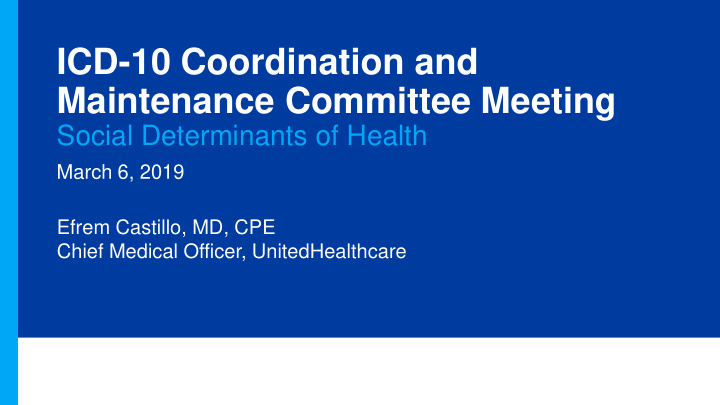



ICD-10 Coordination and Maintenance Committee Meeting Social Determinants of Health March 6, 2019 Efrem Castillo, MD, CPE Chief Medical Officer, UnitedHealthcare
What are Social Determinants of Health? Social determinants are the environmental factors that impact health outcomes, utilization and cost, including financial stability, physical safety, education, housing, transportation, nutrition, community support, and access to care Source: Henry J Kaiser Family Foundation, Beyond Health Care: The Role of Social Determinants in Promoting Health and Health Equity 2 Proprietary information of UnitedHealth Group. Do not distribute or reproduce without express permission of UnitedHealth Group.
By the Numbers: Social Determinants and Health 20% 15 year 85% of health outcomes can be life expectancy difference of physicians report that unmet directly attributed to clinical between the most advantaged social needs lead to poorer care and disadvantaged Americans health outcomes 80% 20% 162,000 of health and well being is tied of physicians are confident in deaths annually to social and economic their ability to address unmet due to low social factors, physical environment social needs support and health behaviors Sources: Robert Wood Johnson Foundation, Kaiser Family Foundation, New England Journal of Medicine, American College of Physicians 3 Proprietary information of UnitedHealth Group. Do not distribute or reproduce without express permission of UnitedHealth Group.
Improving the System by Addressing Social Determinants The Advisory Board: Socioeconomic factors are far stronger determinants of health outcomes than medical care, and addressing Social Determinates of Health has been shown to be effective in improving outcomes. 1 Addressing Non-clinical Three Goals of Population Health Barriers to Care Management Leaders 1 3 2 Missed appointments 25% or rescheduling needs due to transportation Reducing Unnecessary problems Trading High-Cost Services for Enhancing Patient engagement Utilization Low-Cost Care and Care Coordination Annual per-person health $8K care savings as a result of offering housing and supportive services to high-cost homeless individuals • Non-acute ED visits • Expanded primary care access • Chronic condition management • Avoidable readmissions • Medical home enrollment • Improved referrals to specialists and Increased likelihood of a PAC 39% Medicaid-enrolled child visiting an ED more than Non-Clinical Contributors once in a year if living in un-renovated public housing Stable Healthy Educational Access to Parks and housing food options opportunities transportation playgrounds Source: Silver D, et al, “Transportation to clinic,” Journal of Immigrant and Minority Health, 14, no. 2 (2012), 350–355; Kersten EE, et al., “San Francisco Children Living in Redeveloped Figure 2 – Three Goals of Population Health Management Leaders 2 Public Housing Used Acute Services Less than Children in Older Public Housing, Health Affairs, 33, no. 12 (2014), 2230-2237; Corporation for Supportive Housing, “FAQ’s About Supportive Housing Research, http://www.csh.org/wp-content/uploads/2011/11/Cost-Effectiveness- FAQ.pdf; Population Health Advisor research and analysis. 1 The Advisory Board – Social Determinates of Health Data. Educational Briefing for Non-IT Executives 4 2 Advisory Board, “Building the Business Case for Community Partnership.” December 2016 Adobe PDF Presentation
Creating a Consistent Infrastructure Where We Started • Began SDOH collection with 18 existing ICD-10 Z codes Results in 2018 • Developed standardized data collection model and added placeholder codes Members served • Leveraged the PRAPARE tool in data collection expansion (National Association of Community Health Centers-NACHC endorsed) Social referrals • Creates industry model that can be used consistently across payers and providers 5 Proprietary information of UnitedHealth Group. Do not distribute or reproduce without express permission of UnitedHealth Group.
Enabling Whole Person Diagnosis through Social Determinants The Advisory Board: Typical risk stratification Risk stratification inclusive of SDoH It is unlikely Jess will be identified for After SDoH is added to risk intervention until a likely unnecessary stratification model, Jess is identified ED or inpatient event occurs. as a High Priority for intervention. 1 Advisory Board interviews and analysis. “Social Determinates of Health Data, Educational Briefing for Non-IT Executives” 2 Deloitte Insights “ Social determinants of health and Medicaid payments” By Jim Jones, Sima Muller 6 Proprietary information of UnitedHealth Group. Do not distribute or reproduce without express permission of UnitedHealth Group.
Our Recommendation The What • Expand existing code categories to capture, analyze, and act on SDOH data The Why • Social Determinant data provides a more complete, holistic picture of a patient’s health and potential risk factors • ICD-10-CM codes are the standard language between care providers and payers • Building on existing ICD-10 Social Determinant codes significantly expands a physician’s ability to capture information relevant to a patient’s overall condition, improves the ability for comprehensive diagnosis, and promote more coordinated services and care The How • Create new ICD-10-CM attribution codes that better capture the need for social-related services 7 Proprietary information of UnitedHealth Group. Do not distribute or reproduce without express permission of UnitedHealth Group.
Sample: High Volume SDoH Codes and Referrals Current Requested Code Description Sample Referral Agencies Code ICD-10 Code • Birmingham-Jefferson County Transit Authority, Birmingham, AL Unable to get or pay for • Neighborly Care Network, Clearwater, FL transportation for Medical • Paratransit Operations, Miami, FL ZTRAN1 Z59.641 Appointments or Prescriptions • American Lung Association • Walgreen Co. Unable to pay for medical • Hadley Vision Center ZCARE Z59.63 care 8 Proprietary information of UnitedHealth Group. Do not distribute or reproduce without express permission of UnitedHealth Group.
Data Use and Capture: Integration with Provider Workflows Will these codes be used? Yes • Providers already utilize existing ICD-10 Z codes. As represented by UnitedHealthcare, which has received more than 5 million c laims for social barriers using existing ICD-10 Z codes, demonstrating providers do submit codes when available • Much of this data exists in a physician’s electronic medical records as a result of health risk assessments, but without additional ICD-10-CM codes, cannot be coded or captured • These proposed codes are not payer-specific and would integrate into ICD-10-CM standard language between care providers and payers 9 Proprietary information of UnitedHealth Group. Do not distribute or reproduce without express permission of UnitedHealth Group.
Your Questions 10
Thank you
Recommend
More recommend